LDR-615: Change Management Strategies for Veterans' Health Affairs
VerifiedAdded on 2022/10/19
|7
|1702
|15
Report
AI Summary
This report analyzes a change management initiative within Veterans' Health Affairs, specifically addressing the issue of excessive opioid use in treating veterans. It identifies internal and external driving forces, such as the core values of the agency and legal and political pressures, and outlines the stakeholders involved, including healthcare institutions and federal agencies. The report discusses the roles and responsibilities of a change leader, emphasizing the importance of vision, communication, and stakeholder engagement. It proposes the application of Lewin's change management model, detailing the unfreezing, change, and refreezing stages. Potential barriers to change, such as limited understanding and employee engagement, are identified, along with methods to overcome them, including effective communication and stakeholder feedback. The report also outlines evaluation methods, metrics, and strategies for anchoring change, ultimately supporting the organizational mission of providing care to veterans.
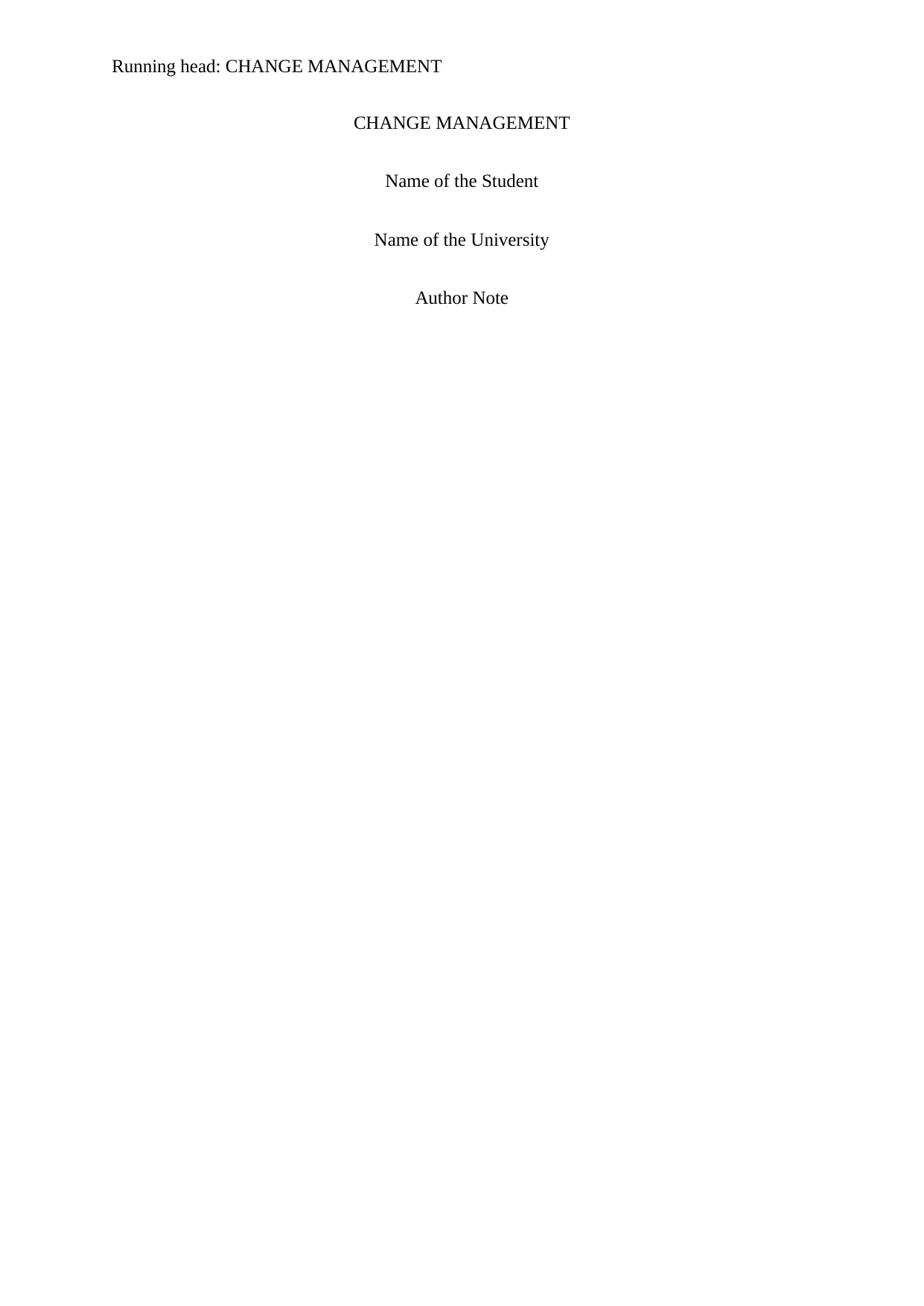
Running head: CHANGE MANAGEMENT
CHANGE MANAGEMENT
Name of the Student
Name of the University
Author Note
CHANGE MANAGEMENT
Name of the Student
Name of the University
Author Note
Paraphrase This Document
Need a fresh take? Get an instant paraphrase of this document with our AI Paraphraser
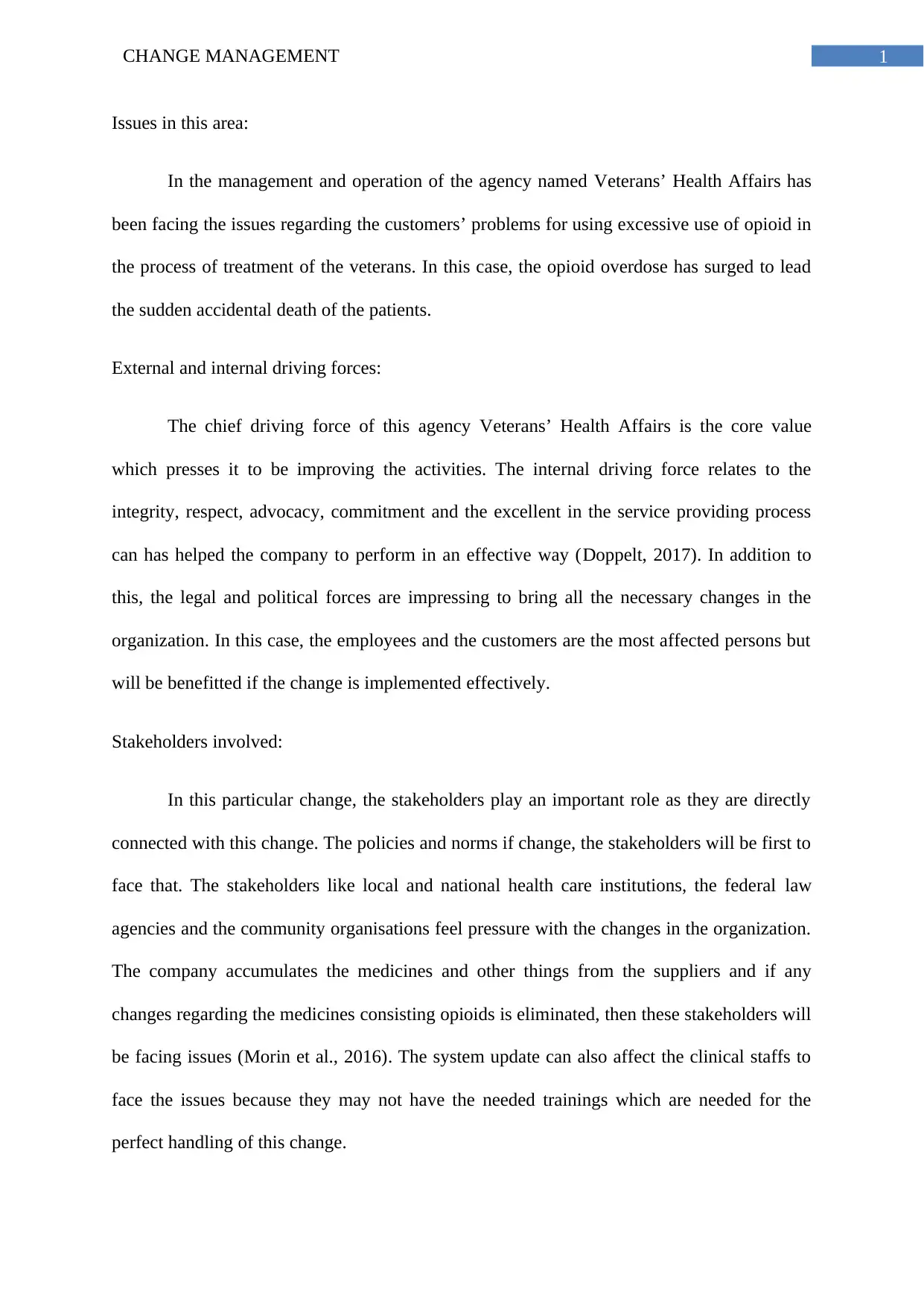
1CHANGE MANAGEMENT
Issues in this area:
In the management and operation of the agency named Veterans’ Health Affairs has
been facing the issues regarding the customers’ problems for using excessive use of opioid in
the process of treatment of the veterans. In this case, the opioid overdose has surged to lead
the sudden accidental death of the patients.
External and internal driving forces:
The chief driving force of this agency Veterans’ Health Affairs is the core value
which presses it to be improving the activities. The internal driving force relates to the
integrity, respect, advocacy, commitment and the excellent in the service providing process
can has helped the company to perform in an effective way (Doppelt, 2017). In addition to
this, the legal and political forces are impressing to bring all the necessary changes in the
organization. In this case, the employees and the customers are the most affected persons but
will be benefitted if the change is implemented effectively.
Stakeholders involved:
In this particular change, the stakeholders play an important role as they are directly
connected with this change. The policies and norms if change, the stakeholders will be first to
face that. The stakeholders like local and national health care institutions, the federal law
agencies and the community organisations feel pressure with the changes in the organization.
The company accumulates the medicines and other things from the suppliers and if any
changes regarding the medicines consisting opioids is eliminated, then these stakeholders will
be facing issues (Morin et al., 2016). The system update can also affect the clinical staffs to
face the issues because they may not have the needed trainings which are needed for the
perfect handling of this change.
Issues in this area:
In the management and operation of the agency named Veterans’ Health Affairs has
been facing the issues regarding the customers’ problems for using excessive use of opioid in
the process of treatment of the veterans. In this case, the opioid overdose has surged to lead
the sudden accidental death of the patients.
External and internal driving forces:
The chief driving force of this agency Veterans’ Health Affairs is the core value
which presses it to be improving the activities. The internal driving force relates to the
integrity, respect, advocacy, commitment and the excellent in the service providing process
can has helped the company to perform in an effective way (Doppelt, 2017). In addition to
this, the legal and political forces are impressing to bring all the necessary changes in the
organization. In this case, the employees and the customers are the most affected persons but
will be benefitted if the change is implemented effectively.
Stakeholders involved:
In this particular change, the stakeholders play an important role as they are directly
connected with this change. The policies and norms if change, the stakeholders will be first to
face that. The stakeholders like local and national health care institutions, the federal law
agencies and the community organisations feel pressure with the changes in the organization.
The company accumulates the medicines and other things from the suppliers and if any
changes regarding the medicines consisting opioids is eliminated, then these stakeholders will
be facing issues (Morin et al., 2016). The system update can also affect the clinical staffs to
face the issues because they may not have the needed trainings which are needed for the
perfect handling of this change.
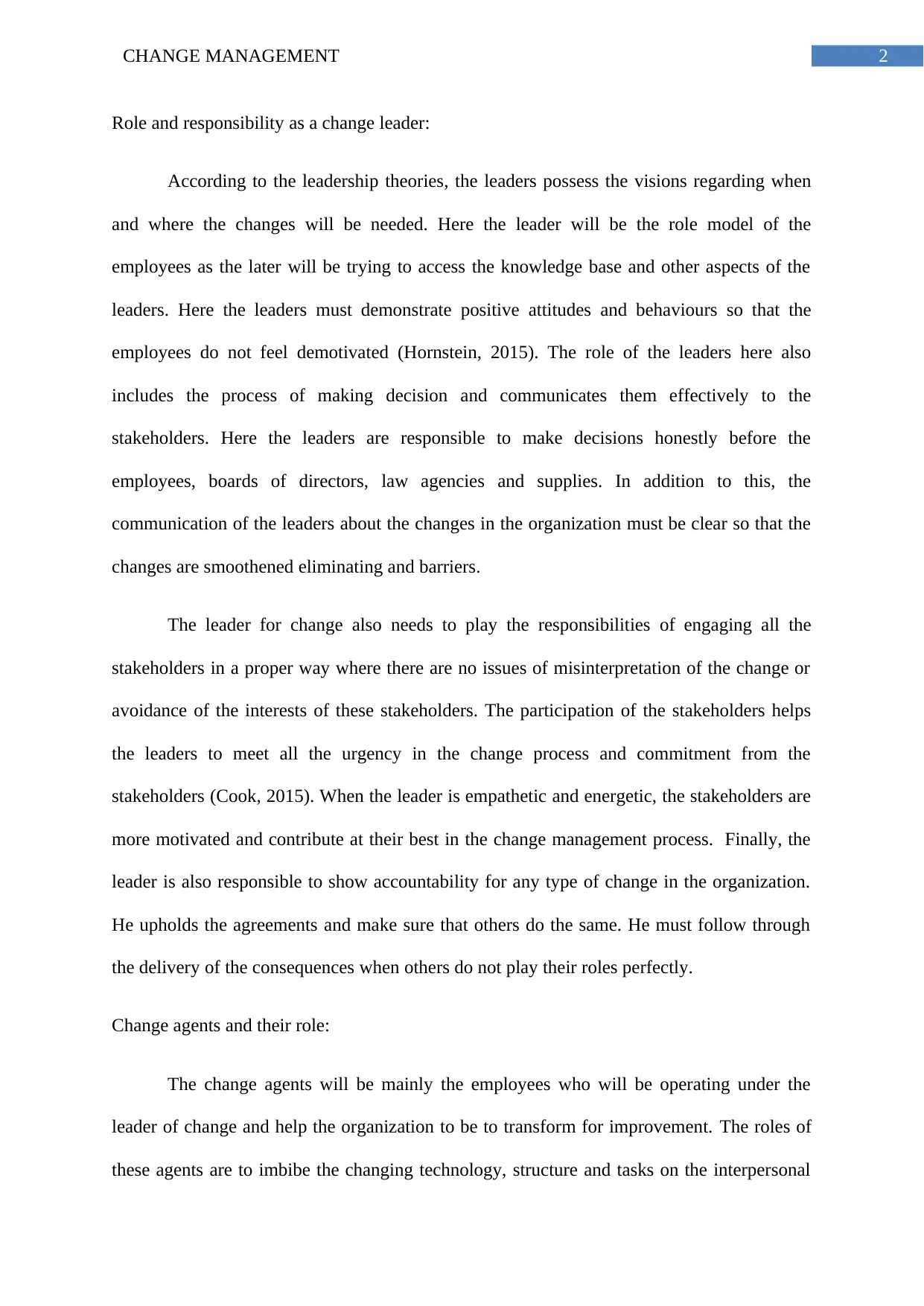
2CHANGE MANAGEMENT
Role and responsibility as a change leader:
According to the leadership theories, the leaders possess the visions regarding when
and where the changes will be needed. Here the leader will be the role model of the
employees as the later will be trying to access the knowledge base and other aspects of the
leaders. Here the leaders must demonstrate positive attitudes and behaviours so that the
employees do not feel demotivated (Hornstein, 2015). The role of the leaders here also
includes the process of making decision and communicates them effectively to the
stakeholders. Here the leaders are responsible to make decisions honestly before the
employees, boards of directors, law agencies and supplies. In addition to this, the
communication of the leaders about the changes in the organization must be clear so that the
changes are smoothened eliminating and barriers.
The leader for change also needs to play the responsibilities of engaging all the
stakeholders in a proper way where there are no issues of misinterpretation of the change or
avoidance of the interests of these stakeholders. The participation of the stakeholders helps
the leaders to meet all the urgency in the change process and commitment from the
stakeholders (Cook, 2015). When the leader is empathetic and energetic, the stakeholders are
more motivated and contribute at their best in the change management process. Finally, the
leader is also responsible to show accountability for any type of change in the organization.
He upholds the agreements and make sure that others do the same. He must follow through
the delivery of the consequences when others do not play their roles perfectly.
Change agents and their role:
The change agents will be mainly the employees who will be operating under the
leader of change and help the organization to be to transform for improvement. The roles of
these agents are to imbibe the changing technology, structure and tasks on the interpersonal
Role and responsibility as a change leader:
According to the leadership theories, the leaders possess the visions regarding when
and where the changes will be needed. Here the leader will be the role model of the
employees as the later will be trying to access the knowledge base and other aspects of the
leaders. Here the leaders must demonstrate positive attitudes and behaviours so that the
employees do not feel demotivated (Hornstein, 2015). The role of the leaders here also
includes the process of making decision and communicates them effectively to the
stakeholders. Here the leaders are responsible to make decisions honestly before the
employees, boards of directors, law agencies and supplies. In addition to this, the
communication of the leaders about the changes in the organization must be clear so that the
changes are smoothened eliminating and barriers.
The leader for change also needs to play the responsibilities of engaging all the
stakeholders in a proper way where there are no issues of misinterpretation of the change or
avoidance of the interests of these stakeholders. The participation of the stakeholders helps
the leaders to meet all the urgency in the change process and commitment from the
stakeholders (Cook, 2015). When the leader is empathetic and energetic, the stakeholders are
more motivated and contribute at their best in the change management process. Finally, the
leader is also responsible to show accountability for any type of change in the organization.
He upholds the agreements and make sure that others do the same. He must follow through
the delivery of the consequences when others do not play their roles perfectly.
Change agents and their role:
The change agents will be mainly the employees who will be operating under the
leader of change and help the organization to be to transform for improvement. The roles of
these agents are to imbibe the changing technology, structure and tasks on the interpersonal
⊘ This is a preview!⊘
Do you want full access?
Subscribe today to unlock all pages.

Trusted by 1+ million students worldwide
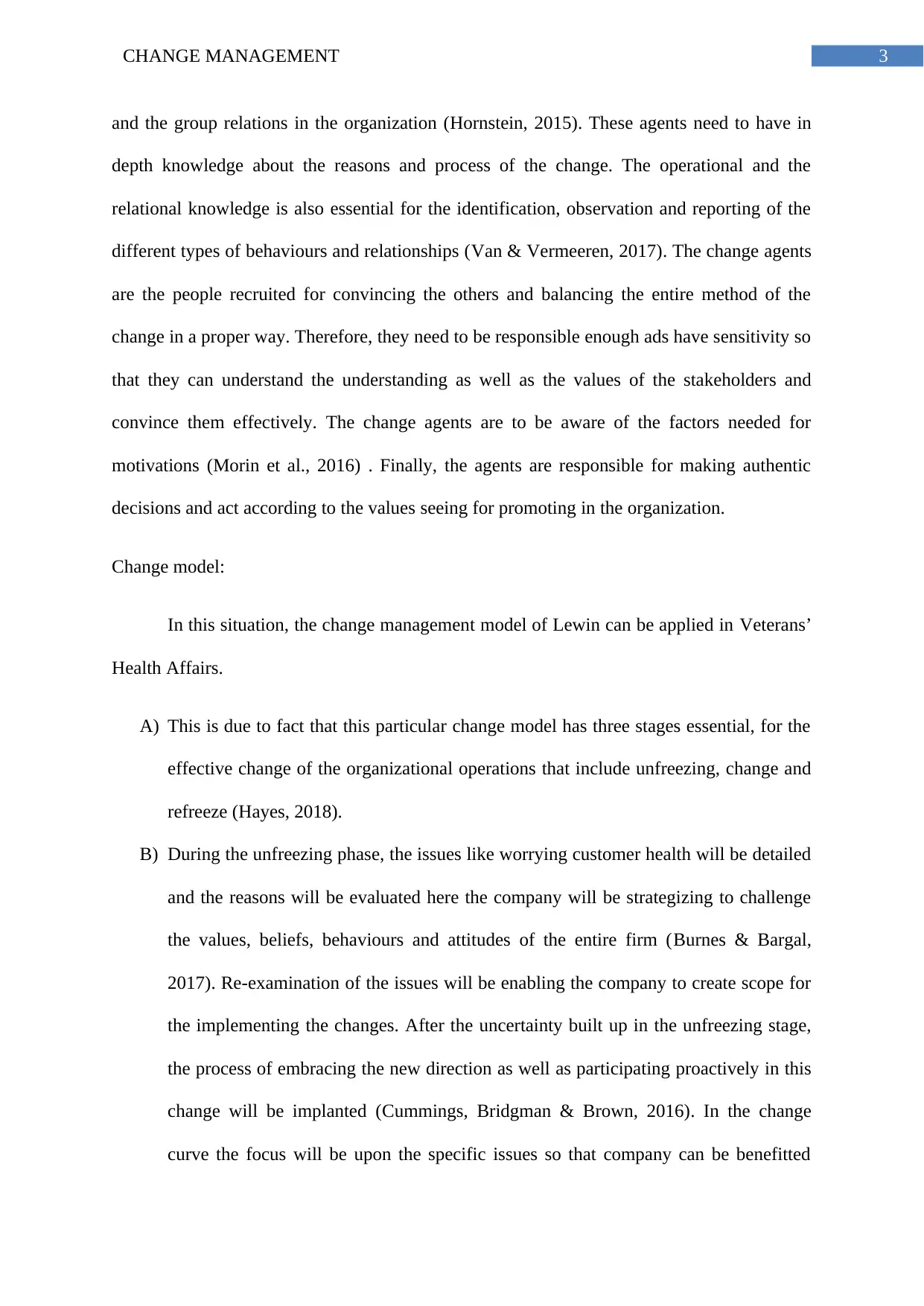
3CHANGE MANAGEMENT
and the group relations in the organization (Hornstein, 2015). These agents need to have in
depth knowledge about the reasons and process of the change. The operational and the
relational knowledge is also essential for the identification, observation and reporting of the
different types of behaviours and relationships (Van & Vermeeren, 2017). The change agents
are the people recruited for convincing the others and balancing the entire method of the
change in a proper way. Therefore, they need to be responsible enough ads have sensitivity so
that they can understand the understanding as well as the values of the stakeholders and
convince them effectively. The change agents are to be aware of the factors needed for
motivations (Morin et al., 2016) . Finally, the agents are responsible for making authentic
decisions and act according to the values seeing for promoting in the organization.
Change model:
In this situation, the change management model of Lewin can be applied in Veterans’
Health Affairs.
A) This is due to fact that this particular change model has three stages essential, for the
effective change of the organizational operations that include unfreezing, change and
refreeze (Hayes, 2018).
B) During the unfreezing phase, the issues like worrying customer health will be detailed
and the reasons will be evaluated here the company will be strategizing to challenge
the values, beliefs, behaviours and attitudes of the entire firm (Burnes & Bargal,
2017). Re-examination of the issues will be enabling the company to create scope for
the implementing the changes. After the uncertainty built up in the unfreezing stage,
the process of embracing the new direction as well as participating proactively in this
change will be implanted (Cummings, Bridgman & Brown, 2016). In the change
curve the focus will be upon the specific issues so that company can be benefitted
and the group relations in the organization (Hornstein, 2015). These agents need to have in
depth knowledge about the reasons and process of the change. The operational and the
relational knowledge is also essential for the identification, observation and reporting of the
different types of behaviours and relationships (Van & Vermeeren, 2017). The change agents
are the people recruited for convincing the others and balancing the entire method of the
change in a proper way. Therefore, they need to be responsible enough ads have sensitivity so
that they can understand the understanding as well as the values of the stakeholders and
convince them effectively. The change agents are to be aware of the factors needed for
motivations (Morin et al., 2016) . Finally, the agents are responsible for making authentic
decisions and act according to the values seeing for promoting in the organization.
Change model:
In this situation, the change management model of Lewin can be applied in Veterans’
Health Affairs.
A) This is due to fact that this particular change model has three stages essential, for the
effective change of the organizational operations that include unfreezing, change and
refreeze (Hayes, 2018).
B) During the unfreezing phase, the issues like worrying customer health will be detailed
and the reasons will be evaluated here the company will be strategizing to challenge
the values, beliefs, behaviours and attitudes of the entire firm (Burnes & Bargal,
2017). Re-examination of the issues will be enabling the company to create scope for
the implementing the changes. After the uncertainty built up in the unfreezing stage,
the process of embracing the new direction as well as participating proactively in this
change will be implanted (Cummings, Bridgman & Brown, 2016). In the change
curve the focus will be upon the specific issues so that company can be benefitted
Paraphrase This Document
Need a fresh take? Get an instant paraphrase of this document with our AI Paraphraser
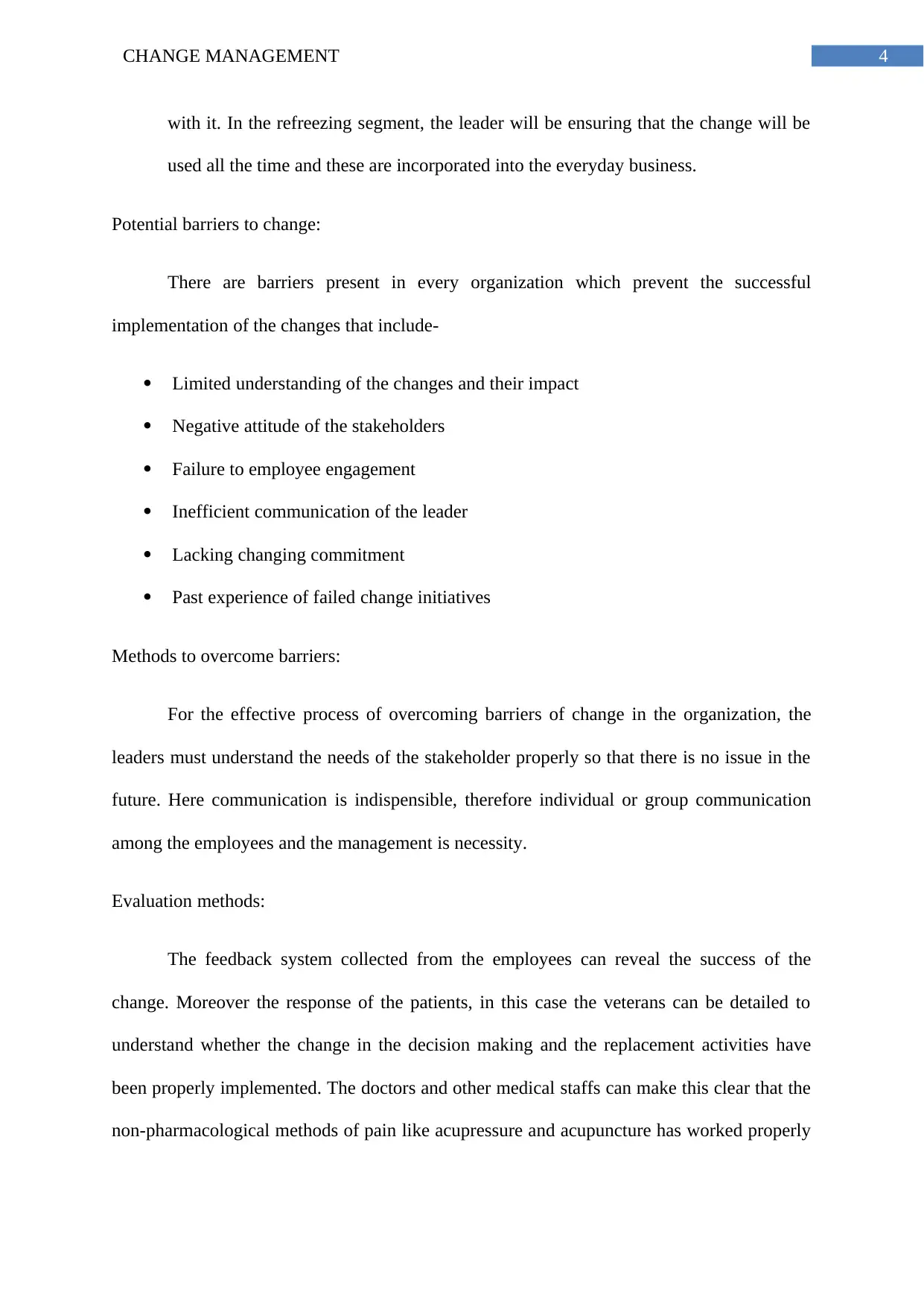
4CHANGE MANAGEMENT
with it. In the refreezing segment, the leader will be ensuring that the change will be
used all the time and these are incorporated into the everyday business.
Potential barriers to change:
There are barriers present in every organization which prevent the successful
implementation of the changes that include-
Limited understanding of the changes and their impact
Negative attitude of the stakeholders
Failure to employee engagement
Inefficient communication of the leader
Lacking changing commitment
Past experience of failed change initiatives
Methods to overcome barriers:
For the effective process of overcoming barriers of change in the organization, the
leaders must understand the needs of the stakeholder properly so that there is no issue in the
future. Here communication is indispensible, therefore individual or group communication
among the employees and the management is necessity.
Evaluation methods:
The feedback system collected from the employees can reveal the success of the
change. Moreover the response of the patients, in this case the veterans can be detailed to
understand whether the change in the decision making and the replacement activities have
been properly implemented. The doctors and other medical staffs can make this clear that the
non-pharmacological methods of pain like acupressure and acupuncture has worked properly
with it. In the refreezing segment, the leader will be ensuring that the change will be
used all the time and these are incorporated into the everyday business.
Potential barriers to change:
There are barriers present in every organization which prevent the successful
implementation of the changes that include-
Limited understanding of the changes and their impact
Negative attitude of the stakeholders
Failure to employee engagement
Inefficient communication of the leader
Lacking changing commitment
Past experience of failed change initiatives
Methods to overcome barriers:
For the effective process of overcoming barriers of change in the organization, the
leaders must understand the needs of the stakeholder properly so that there is no issue in the
future. Here communication is indispensible, therefore individual or group communication
among the employees and the management is necessity.
Evaluation methods:
The feedback system collected from the employees can reveal the success of the
change. Moreover the response of the patients, in this case the veterans can be detailed to
understand whether the change in the decision making and the replacement activities have
been properly implemented. The doctors and other medical staffs can make this clear that the
non-pharmacological methods of pain like acupressure and acupuncture has worked properly
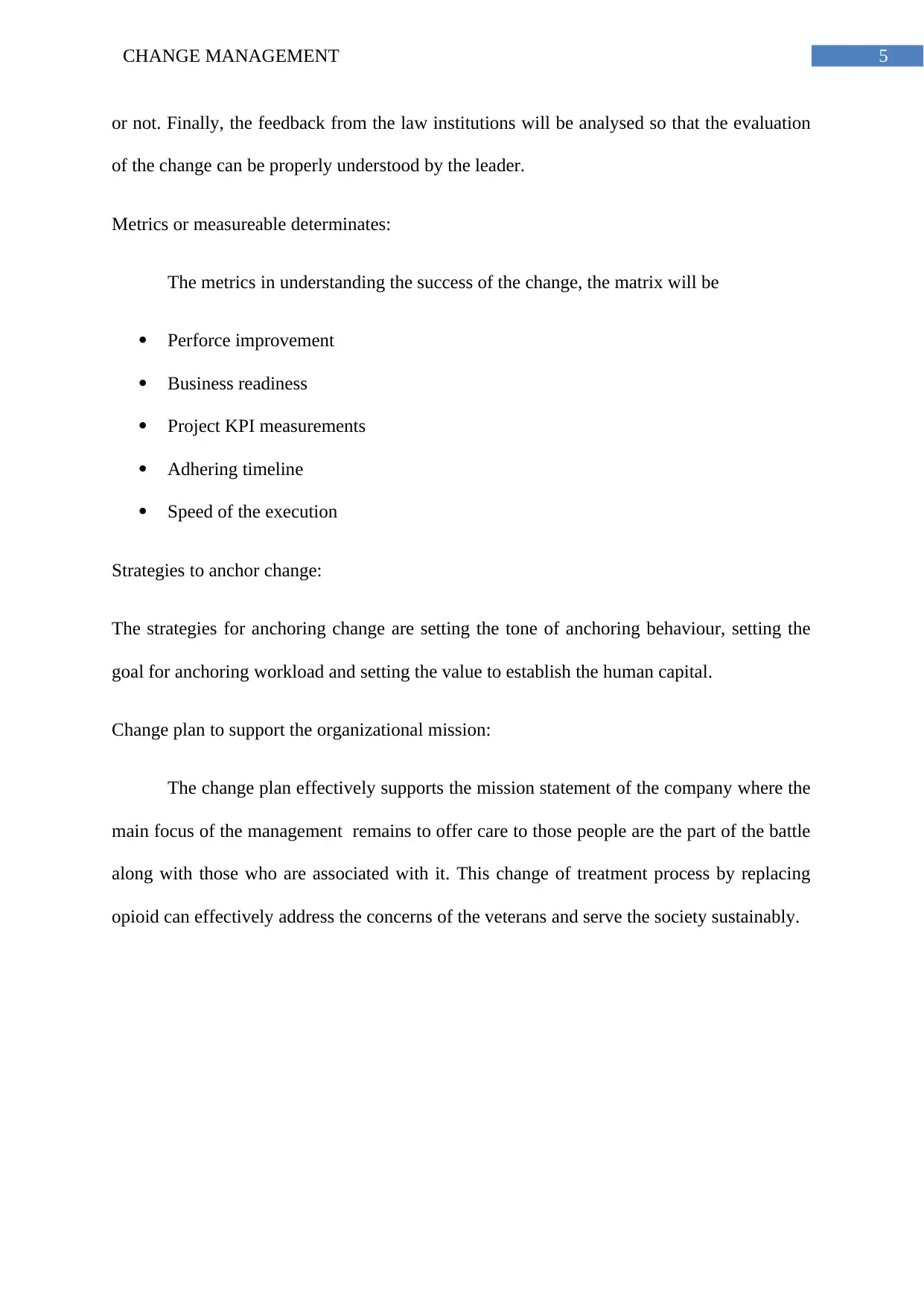
5CHANGE MANAGEMENT
or not. Finally, the feedback from the law institutions will be analysed so that the evaluation
of the change can be properly understood by the leader.
Metrics or measureable determinates:
The metrics in understanding the success of the change, the matrix will be
Perforce improvement
Business readiness
Project KPI measurements
Adhering timeline
Speed of the execution
Strategies to anchor change:
The strategies for anchoring change are setting the tone of anchoring behaviour, setting the
goal for anchoring workload and setting the value to establish the human capital.
Change plan to support the organizational mission:
The change plan effectively supports the mission statement of the company where the
main focus of the management remains to offer care to those people are the part of the battle
along with those who are associated with it. This change of treatment process by replacing
opioid can effectively address the concerns of the veterans and serve the society sustainably.
or not. Finally, the feedback from the law institutions will be analysed so that the evaluation
of the change can be properly understood by the leader.
Metrics or measureable determinates:
The metrics in understanding the success of the change, the matrix will be
Perforce improvement
Business readiness
Project KPI measurements
Adhering timeline
Speed of the execution
Strategies to anchor change:
The strategies for anchoring change are setting the tone of anchoring behaviour, setting the
goal for anchoring workload and setting the value to establish the human capital.
Change plan to support the organizational mission:
The change plan effectively supports the mission statement of the company where the
main focus of the management remains to offer care to those people are the part of the battle
along with those who are associated with it. This change of treatment process by replacing
opioid can effectively address the concerns of the veterans and serve the society sustainably.
⊘ This is a preview!⊘
Do you want full access?
Subscribe today to unlock all pages.

Trusted by 1+ million students worldwide
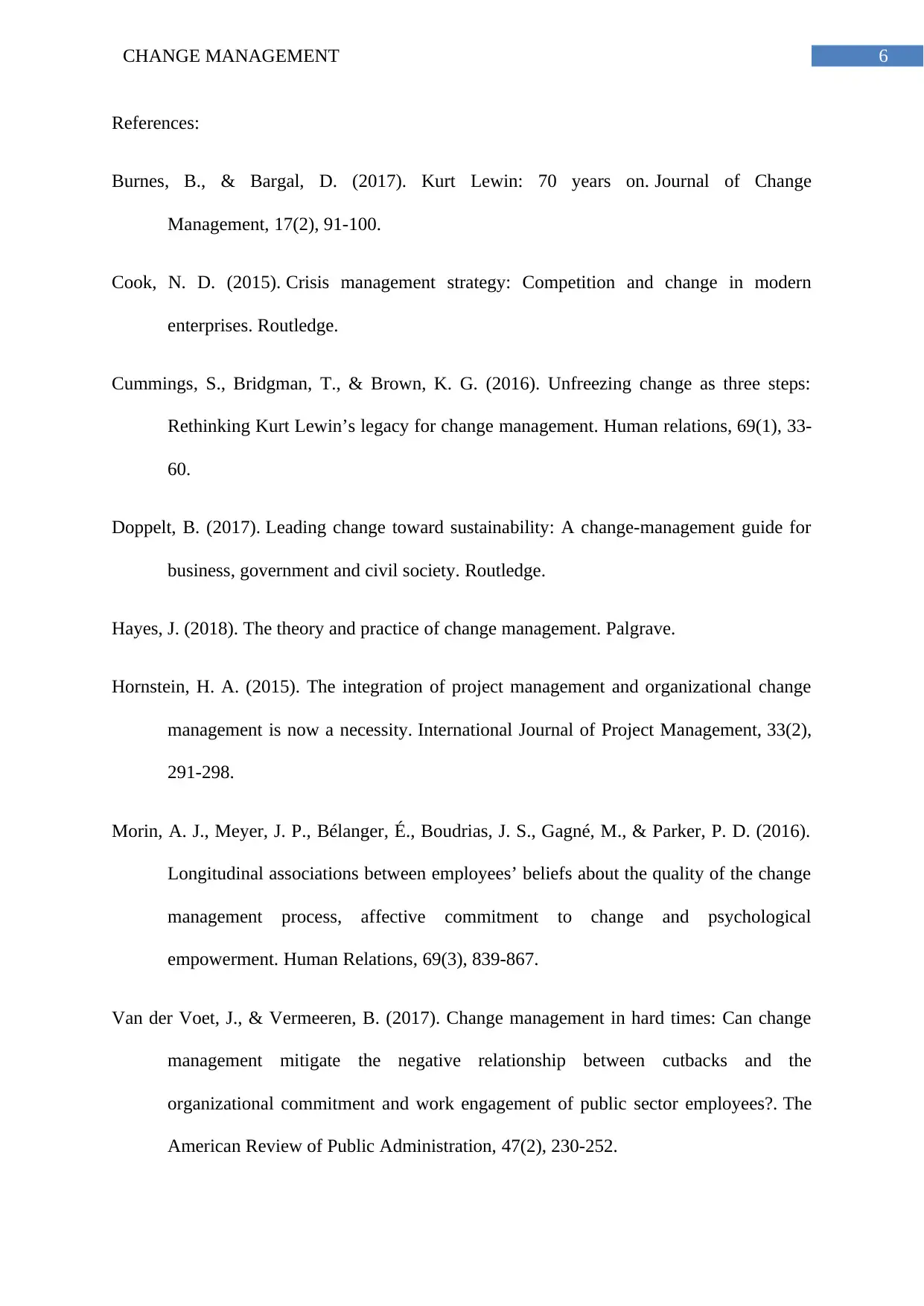
6CHANGE MANAGEMENT
References:
Burnes, B., & Bargal, D. (2017). Kurt Lewin: 70 years on. Journal of Change
Management, 17(2), 91-100.
Cook, N. D. (2015). Crisis management strategy: Competition and change in modern
enterprises. Routledge.
Cummings, S., Bridgman, T., & Brown, K. G. (2016). Unfreezing change as three steps:
Rethinking Kurt Lewin’s legacy for change management. Human relations, 69(1), 33-
60.
Doppelt, B. (2017). Leading change toward sustainability: A change-management guide for
business, government and civil society. Routledge.
Hayes, J. (2018). The theory and practice of change management. Palgrave.
Hornstein, H. A. (2015). The integration of project management and organizational change
management is now a necessity. International Journal of Project Management, 33(2),
291-298.
Morin, A. J., Meyer, J. P., Bélanger, É., Boudrias, J. S., Gagné, M., & Parker, P. D. (2016).
Longitudinal associations between employees’ beliefs about the quality of the change
management process, affective commitment to change and psychological
empowerment. Human Relations, 69(3), 839-867.
Van der Voet, J., & Vermeeren, B. (2017). Change management in hard times: Can change
management mitigate the negative relationship between cutbacks and the
organizational commitment and work engagement of public sector employees?. The
American Review of Public Administration, 47(2), 230-252.
References:
Burnes, B., & Bargal, D. (2017). Kurt Lewin: 70 years on. Journal of Change
Management, 17(2), 91-100.
Cook, N. D. (2015). Crisis management strategy: Competition and change in modern
enterprises. Routledge.
Cummings, S., Bridgman, T., & Brown, K. G. (2016). Unfreezing change as three steps:
Rethinking Kurt Lewin’s legacy for change management. Human relations, 69(1), 33-
60.
Doppelt, B. (2017). Leading change toward sustainability: A change-management guide for
business, government and civil society. Routledge.
Hayes, J. (2018). The theory and practice of change management. Palgrave.
Hornstein, H. A. (2015). The integration of project management and organizational change
management is now a necessity. International Journal of Project Management, 33(2),
291-298.
Morin, A. J., Meyer, J. P., Bélanger, É., Boudrias, J. S., Gagné, M., & Parker, P. D. (2016).
Longitudinal associations between employees’ beliefs about the quality of the change
management process, affective commitment to change and psychological
empowerment. Human Relations, 69(3), 839-867.
Van der Voet, J., & Vermeeren, B. (2017). Change management in hard times: Can change
management mitigate the negative relationship between cutbacks and the
organizational commitment and work engagement of public sector employees?. The
American Review of Public Administration, 47(2), 230-252.
1 out of 7
Related Documents
Your All-in-One AI-Powered Toolkit for Academic Success.
+13062052269
info@desklib.com
Available 24*7 on WhatsApp / Email
![[object Object]](/_next/static/media/star-bottom.7253800d.svg)
Unlock your academic potential
Copyright © 2020–2025 A2Z Services. All Rights Reserved. Developed and managed by ZUCOL.





